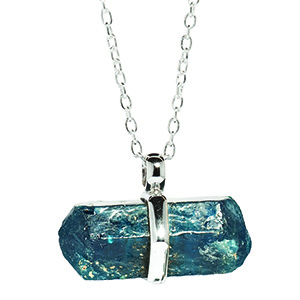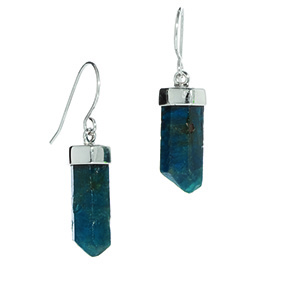
What would life be without challenges? The victorious air punch once you’ve identified a stone is a work place hazard, but also a part of the fun of being a gemmologist. Apatite is one of those sneaky stones that likes to play dress up and makes our detective work all the more challenging.
A lesser-known gem in the mainstream jewellery world, the apatite group has a lot to offer the world of gemmology. The Greek word apate translates as ‘deceit’, given that this gemstone not only looks like other gems and crystals it is also regularly confused for other gems because of similar readings in the lab it’s often referred to as the ‘deceiver’.
Apatite is a group of phosphate minerals belonging to the hexagonal crystal system.It has a varying chemical formula of Ca5(PO4)3(F,Cl,OH) where Ca may be replaced by Mn, Mg, Sr or rare earths (Nd, Pr), Ce, or U and substitution in the terminal group yields fluorapatite, hydroxyapatite, chlorapatite or carbonate-apatite. Gem apatites are typically the fluorine-rich type, known as fluorapatites.
Colours are typically yellow-brown, yellow-green to green-blue, with vivid blue apatite being particularly rare and popular. Not only does apatite get confused for many other minerals it also plays host to them as well with typical inclusions of tourmaline, glass, biotite, goethite, hematite, manganese oxide, and pyrrhotite. Crystals are either short hexagonal prisms or hexagonal tabular. Although chatoyancy is a very common phenomenon in green or yellow apatite, deep blue apatite with a cat’s-eye effect is quite rare. A favourite crystal of his collection, Bunny, Made In Earth’s owner and designer, loves the drama these deep blue/green crystals bring to his jewellery designs.
“Apatite crystals are a nice break from the transparent quartz and tourmaline. The deep blues bring a burst of colour and their well-defined crystal forms add bold shapes to my designs. Although I love our apatite crystals, I’ve recently added cat’s eye apatite cabochons to our collection. The sheen contrasts against the blue/green body colour of the stones to really show off this phenomenon. Like most gemstones, the price of apatite has risen so obtaining these unusual varieties is becoming more difficult.”
With a hardness of 5 on MOHs scale, Apatite is a relatively soft stone and should be worn with caution. Its softness can make it difficult to cut and polish, something Bunny has had experience with.
“We tend to have rough with beautiful deep blue colour but lacking the translucency to really see its potential. I’ve managed to polish some cabochons into slices so that the light can transmit through the stone. The end result is amazing but the softness of apatite means we’ve lost a few stones in the process.”
While gemmologists are accustomed to gem-trickery and the challenge of the unknown, there will always be gems that fly under the radar and pop up when we least expect it (we should be used to it by now). Apatite masquerades as other gems although it has its own unique beauty to be adored.
